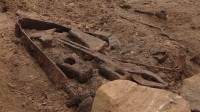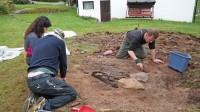 Leif Arne Nordheim, long annoyed by a group of flagstones that poked up above ground level impeding the path of his lawnmower, borrowed his neighbor’s backhoe to remove them. At first the job was uneventful, but when he was finishing up with the last of the slabs, he unearthed what looked like a large pair of pliers or tongs. They looked like they might be a couple of hundred of years old but he didn’t think much of it until he came across a bent sword next. That’s when he realized they might be archaeological artifacts rather than old tools and called in the experts.
Leif Arne Nordheim, long annoyed by a group of flagstones that poked up above ground level impeding the path of his lawnmower, borrowed his neighbor’s backhoe to remove them. At first the job was uneventful, but when he was finishing up with the last of the slabs, he unearthed what looked like a large pair of pliers or tongs. They looked like they might be a couple of hundred of years old but he didn’t think much of it until he came across a bent sword next. That’s when he realized they might be archaeological artifacts rather than old tools and called in the experts.
Archaeologists from the county Cultural Department and Bergen University came to excavate the site. They found an axe and several other pieces of metalwork that stylistically date to the 8th or 9th century A.D. State Conservationist Eva Moberg noted that this is an extremely rare find. The last time similar artifacts were unearthed was in 1913 at the grave of Viking blacksmith. Although no human remains were discovered in Mr. Nordheim’s back yard, it’s possible that this too was a deposit of grave goods for the person who used those tongs in life.
 The excavation is continuing at county expense. The artifacts will be conserved and ultimately put on public display at the University Museum of Bergen. There’s excellent video of the yard and excavation in this news story which is almost entirely in Norwegian except for one archaeologist’s comments that are in English.
The excavation is continuing at county expense. The artifacts will be conserved and ultimately put on public display at the University Museum of Bergen. There’s excellent video of the yard and excavation in this news story which is almost entirely in Norwegian except for one archaeologist’s comments that are in English.
This is not the first time notable archaeological objects have been discovered in the area. In 1917, a farmer turned up the Eggja stone while plowing a field just a kilometer from the Nordheim homestead. The stone, found face-down over the grave of an adult male, is inscribed with about 200 runes of Elder Futhark, the oldest runic alphabet. It dates to 650-700 A.D. and is the longest surviving inscription of Elder Futhark. There are multiple possible interpretations of the runes on the Eggja stone, see the Rune Project database for possible translations of section 1, 2 and 3).
